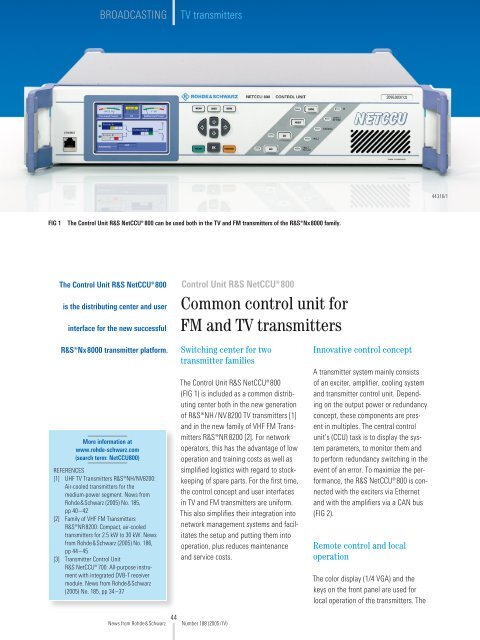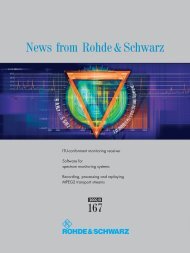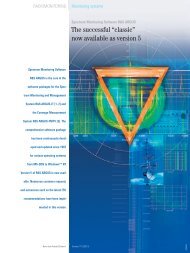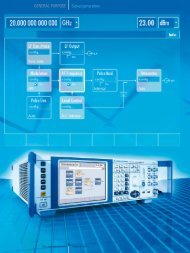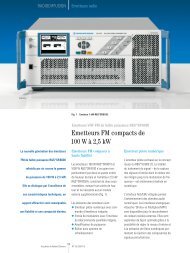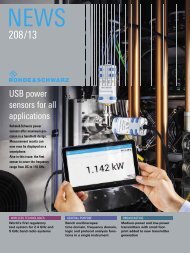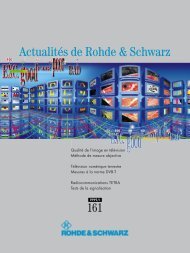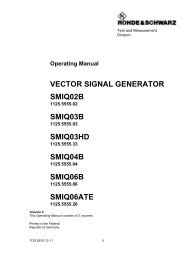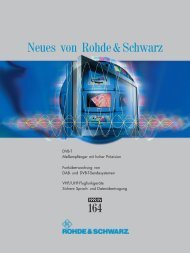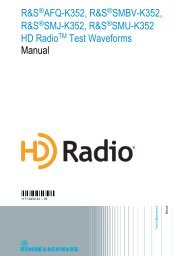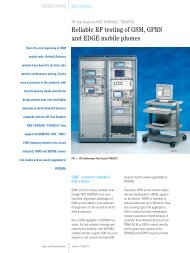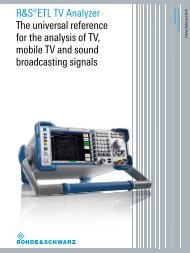Common control unit for FM and TV transmitters - Rohde & Schwarz
Common control unit for FM and TV transmitters - Rohde & Schwarz
Common control unit for FM and TV transmitters - Rohde & Schwarz
You also want an ePaper? Increase the reach of your titles
YUMPU automatically turns print PDFs into web optimized ePapers that Google loves.
BROADCASTING<strong>TV</strong> <strong>transmitters</strong>44316/1FIG 1The Control Unit R&S NetCCU® 800 can be used both in the <strong>TV</strong> <strong>and</strong> <strong>FM</strong> <strong>transmitters</strong> of the R&S®Nx8000 family.The Control Unit R&S NetCCU®800is the distributing center <strong>and</strong> userinterface <strong>for</strong> the new successfulControl Unit R&S NetCCU®800<strong>Common</strong> <strong>control</strong> <strong>unit</strong> <strong>for</strong><strong>FM</strong> <strong>and</strong> <strong>TV</strong> <strong>transmitters</strong>R&S®Nx8000 transmitter plat<strong>for</strong>m.More in<strong>for</strong>mation atwww.rohde-schwarz.com(search term: NetCCU800)REFERENCES[1] UHF <strong>TV</strong> Transmitters R&S®NH/NV8200:Air-cooled <strong>transmitters</strong> <strong>for</strong> themedium-power segment. News from<strong>Rohde</strong>&<strong>Schwarz</strong> (2005) No. 185,pp 40–42[2] Family of VHF <strong>FM</strong> TransmittersR&S®NR8200: Compact, air-cooled<strong>transmitters</strong> <strong>for</strong> 2.5 kW to 30 kW. Newsfrom <strong>Rohde</strong>&<strong>Schwarz</strong> (2005) No. 186,pp 44–45[3] Transmitter Control UnitR&S NetCCU® 700: All-purpose instrumentwith integrated DVB-T receivermodule. News from <strong>Rohde</strong>&<strong>Schwarz</strong>(2005) No. 185, pp 34–37Switching center <strong>for</strong> twotransmitter familiesThe Control Unit R&S NetCCU®800(FIG 1) is included as a common distributingcenter both in the new generationof R&S®NH/NV8200 <strong>TV</strong> <strong>transmitters</strong> [1]<strong>and</strong> in the new family of VHF <strong>FM</strong> TransmittersR&S®NR8200 [2]. For networkoperators, this has the advantage of lowoperation <strong>and</strong> training costs as well assimplified logistics with regard to stockkeepingof spare parts. For the first time,the <strong>control</strong> concept <strong>and</strong> user interfacesin <strong>TV</strong> <strong>and</strong> <strong>FM</strong> <strong>transmitters</strong> are uni<strong>for</strong>m.This also simplifies their integration intonetwork management systems <strong>and</strong> facilitatesthe setup <strong>and</strong> putting them intooperation, plus reduces maintenance<strong>and</strong> service costs.Innovative <strong>control</strong> conceptA transmitter system mainly consistsof an exciter, amplifier, cooling system<strong>and</strong> transmitter <strong>control</strong> <strong>unit</strong>. Dependingon the output power or redundancyconcept, these components are presentin multiples. The central <strong>control</strong><strong>unit</strong>’s (CCU) task is to display the systemparameters, to monitor them <strong>and</strong>to per<strong>for</strong>m redundancy switching in theevent of an error. To maximize the per<strong>for</strong>mance,the R&S NetCCU®800 is connectedwith the exciters via Ethernet<strong>and</strong> with the amplifiers via a CAN bus(FIG 2).Remote <strong>control</strong> <strong>and</strong> localoperationThe color display (1/4 VGA) <strong>and</strong> thekeys on the front panel are used <strong>for</strong>local operation of the <strong>transmitters</strong>. The44News from <strong>Rohde</strong>&<strong>Schwarz</strong> Number 188 (2005/IV)
straight<strong>for</strong>ward menus provide access toall parameters of the transmitter system.You can call up setting ranges <strong>and</strong> abrief description <strong>for</strong> each parameter; thisespecially facilitates the system‘s occasionalon-site use (FIG 3).ExciterR&S NetCCU®800Since the R&S NetCCU®800 uses Javasoftware <strong>and</strong> the XML description language,the menus can easily be adaptedto customer-specific requirements (e.g.other languages).In addition to the increasingly importantremote <strong>control</strong> of unattended stations,network management systems of thenetwork operator can be directly connectedwith the <strong>control</strong> <strong>unit</strong> <strong>and</strong> communicatewith its integrated SNMP agent.The agent automatically in<strong>for</strong>ms the <strong>control</strong>center about errors on the <strong>transmitters</strong>tation via SNMP trap. The CCU isalso equipped with a web server, providingthe maintenance personnel, whichis often at different sites, access to allparameters of the transmitter systemvia a st<strong>and</strong>ard web browser when <strong>and</strong>where needed (FIG 4). Structure <strong>and</strong>content of the menus are identical to thelocal operation of the transmitter via display.EthernetEthernetLocal <strong>control</strong>AmplifierCAN busFIG 2Designed to achieve highper<strong>for</strong>mance: The ControlUnit R&S NetCCU®800 communicatesvia Ethernet or aCAN bus with the transmittercomponents.FIG 3For local operation, the instrumentdisplay provides comprehensivein<strong>for</strong>mation aboutthe transmitter parameters.DVB-T receiver module optionFIG 4Convenient remote <strong>control</strong> via a web browser.As with the predecessor model of the<strong>control</strong> <strong>unit</strong>, the DVB-T receiver moduleoption [3] is available <strong>for</strong> monitoringthe output signal of a DVB-T transmitter.This allows monitoring of importantparameters such as MER, BER, S/N,input level <strong>and</strong> modulation mode <strong>and</strong>call them up via the user interfaces(local, SNMP <strong>and</strong> web). In the retransmitterapplication, this option is used tocost-efficiently feed the modulation signalwhen receiving the RF of a mastertransmitter.Manfred Reitmeier45News from <strong>Rohde</strong>&<strong>Schwarz</strong> Number 188 (2005/IV)


